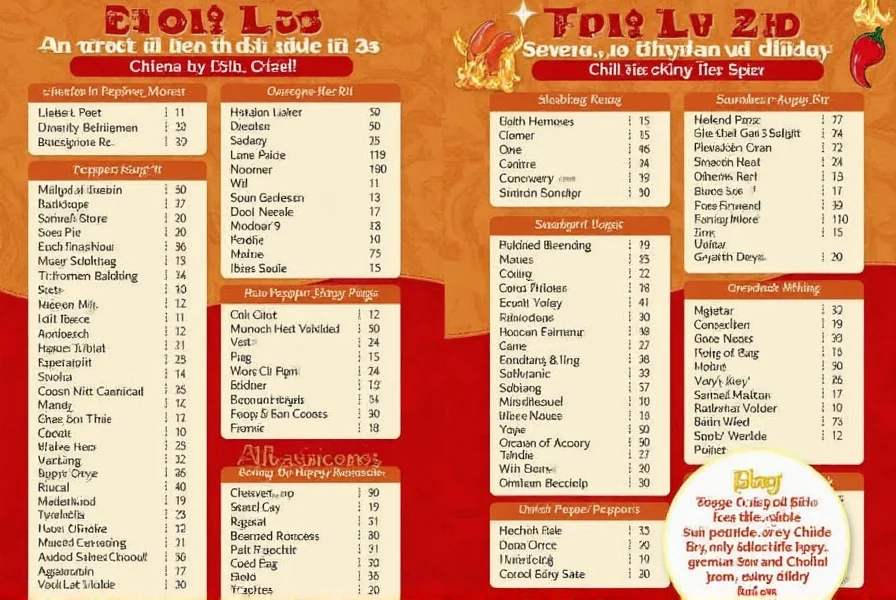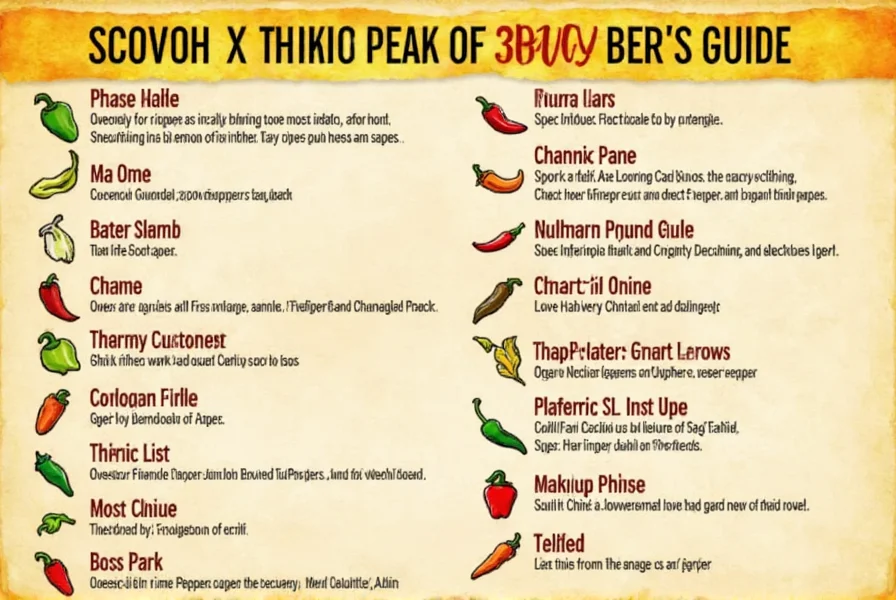Chili List Scoville: The Ultimate Heat Lover's Guide to Spicy Peppers!
If you're a spice lover or just curious about what makes your tongue tingle, this is the article for you! We’ll dive into everything related to the chili list scoville, from mild jalapeños to fiery ghost peppers. Whether you’re planning your next salsa recipe or entering a hot wing eating contest, this guide will help you understand and compare the heat levels of different chilies like a pro.
Table of Contents
- Introduction to the Scoville Scale
- The Ultimate Chili List by Scoville Rating
- What Makes Chilies Hot? Understanding Capsaicin
- How to Use Different Chilies in Cooking
- Buying Guide: Choosing the Right Chili for You
- Conclusion
Introduction to the Scoville Scale
The Scoville scale, named after its creator Wilbur Scoville, is the standard measurement used to determine the spiciness or “heat” of chili peppers. It measures the concentration of capsaicin — the compound responsible for the burning sensation we associate with spicy food.
Originally developed in 1912 using human taste testers and sugar water dilutions, modern technology now uses high-performance liquid chromatography (HPLC) to measure capsaicin levels more accurately. The results are still expressed in Scoville Heat Units (SHU).

The Ultimate Chili List by Scoville Rating
Let’s take a look at some of the most popular and widely available chilies ranked by their Scoville rating. This list includes both fresh and dried varieties so you can choose the right one for your palate and your dish.
| Chili Name | Scoville Heat Units (SHU) | Flavor Profile | Common Uses |
|---|---|---|---|
| Bell Pepper | 0 SHU | Sweet, crisp, and juicy | Salads, stuffed dishes, stir-fries |
| Poblano | 1,000–2,000 SHU | Earthy, rich, slightly sweet | Mole sauces, chiles rellenos |
| Jalapeño | 2,500–8,000 SHU | Grassy, bright, slightly smoky | Salsas, nachos, pickled dishes |
| Serrano | 10,000–23,000 SHU | Sharp, acidic, crisp bite | Salsas, soups, sauces |
| Cayenne | 30,000–50,000 SHU | Spicy, earthy, bold | Spice blends, hot sauces |
| Hatch Green Chile | 1,000–15,000 SHU (varies) | Smoky, vegetal, fruity | Enchiladas, green sauces |
| Habanero | 100,000–350,000 SHU | Fruity, floral, intensely hot | Hot sauces, Caribbean dishes |
| Ghost Pepper (Bhut Jolokia) | 1,000,000 SHU | Earthy, smoky, explosive heat | Challenge cooking, hot sauces |
| Carolina Reaper | 1,400,000–2,200,000 SHU | Fruity, sweet, then fiery | World record hot sauces, dares |
What Makes Chilies Hot? Understanding Capsaicin
Capsaicin is the primary chemical compound that gives chilies their heat. Found mainly in the white pith and seeds inside the pepper, capsaicin stimulates nerve endings in the skin and mouth, triggering a sensation of burning or pain — even though it doesn’t actually cause any physical damage.
Interestingly, birds are immune to capsaicin, which may explain why chili seeds are often dispersed through bird droppings without being digested. Humans, on the other hand, have developed a love-hate relationship with the spicy kick that chilies provide.
Did you know? Eating dairy (like yogurt or milk) helps neutralize the burn because casein binds to capsaicin and washes it away. So next time you bite into something too hot, reach for a glass of milk instead of water!

How to Use Different Chilies in Cooking
Understanding how to incorporate chilies into your cooking based on their Scoville rating can make all the difference in flavor and heat control. Here are some handy tips:
- Mild Chilies (0–5,000 SHU): Perfect for everyday use. Think bell peppers, poblanos, and mild jalapeños. Great for stuffing, roasting, or adding a subtle flavor boost.
- Medium Chilies (5,000–50,000 SHU): These offer a bit more punch but are still versatile. Serranos and cayennes add heat without overwhelming the palate. Ideal for salsas, soups, and marinades.
- Hot Chilies (50,000–300,000 SHU): For those who enjoy a real kick. Habaneros bring a fruity fire that works well in tropical-style sauces and Caribbean cuisine. Use sparingly and always wear gloves when handling!
- Super-Hot Chilies (300,000+ SHU): Not for the faint of heart. Ghost peppers and Carolina Reapers should be handled with extreme care. These are best used in small quantities for intense hot sauces or novelty recipes.
Buying Guide: Choosing the Right Chili for You
Whether you’re shopping at a local market or browsing online spice retailers, here’s how to choose the perfect chili for your needs.
For Beginners
- Bell Peppers: Zero heat, full flavor. Great for salads and veggie dishes.
- Poblano Peppers: Mild with a deep flavor. Often used in Mexican cooking.
- Jalapeños: A staple in many kitchens. Offers moderate heat with lots of versatility.
For Spice Enthusiasts
- Cayenne Powder: Adds heat easily to sauces, stews, and rubs.
- Habanero Peppers: Fruity heat profile. Ideal for homemade hot sauces.
- Ghost Pepper Flakes: Intense heat. Great for seasoning meats or making DIY super-hot sauces.
For Extreme Heat Seekers
- Carolina Reaper Seeds or Powder: World’s hottest pepper. Use in very small amounts for maximum effect.
- Dried Trinidad Moruga Scorpion: Another ultra-spicy option for serious heat lovers.
Product Highlights
Organic Cayenne Powder – 100g
Features: Non-GMO, organic, ground from mature peppers
Advantages: Easy to use, highly concentrated heat
Best For: Adding heat to soups, stews, and spice blends
Use Cases: Everyday cooking, spice mixes, hot sauces
Ghost Pepper Seasoning Blend
Features: Smoked ghost pepper, sea salt, garlic powder
Advantages: Balanced flavor with extreme heat
Best For: Grilled meats, roasted vegetables, popcorn
Use Cases: BBQs, game nights, adventurous eaters
Carolina Reaper Hot Sauce – 150ml
Features: Made from fresh Carolina Reapers, vinegar-based
Advantages: Pure heat with minimal additives
Best For: Wings, tacos, challenge recipes
Use Cases: Dips, drizzling, heat challenges
Conclusion
Whether you're just dipping your toes into the world of spicy foods or you're already chasing the thrill of the world's hottest peppers, the chili list scoville is your go-to tool for navigating the heat spectrum. Armed with this knowledge, you can confidently explore new flavors, enhance your meals, and impress your friends with your chili expertise.
Remember: always respect the heat, wear gloves when handling super-hot chilies, and keep some milk or yogurt nearby — just in case!
So, are you ready to turn up the heat in your kitchen? Grab your favorite chili, and let’s get cooking!










 浙公网安备
33010002000092号
浙公网安备
33010002000092号 浙B2-20120091-4
浙B2-20120091-4